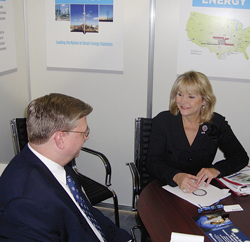Vol. 233 No. 7
KURT ABRAHAM, EXECUTIVE EDITOR
|
Oklahoma fills gaps left by feds
|

|
Forgive me, our dedicated readers, for I am in a foul mood this month. It is not a happy time to be in the U.S. We have a federal administration that seems hell-bent on side-stepping Congress and the U.S. Constitution at every turn. We also have a Supreme Court chief justice, who, by all appearances, seems to be mentally out-to-lunch. Then there is the never-ending presidential election season that is increasingly irritating. On top of that, the federal government manages to bungle or worsen every angle of the U.S. energy system that it touches.
So, it is indeed a bright spot in U.S. politics, to see some responsible, adult behavior exhibited by some of the state governments. A shining example of this is Oklahoma’s policy toward energy, particularly oil and gas, led by Governor Mary Fallin (Rep.). As the governor explained to me in a recent exclusive interview, the state of Oklahoma is taking a very proactive stance toward energy development. This includes encouraging more traditional oil and gas production, boosting shale E&P, pushing a program of greater natural gas utilization for transportation and industrial uses, and expanding development of alternative energy forms.
To tie a neat bow around this large bag of energy development, the state has fashioned its Oklahoma First Energy Plan. The brainchild of Governor Fallin and her staff, along with input from state departments and the legislature, the plan is designed to “Foster economic development, transition transportation fuels, optimize the existing energy system, and position Oklahoma for the future by pragmatically leveraging Oklahoma resources.” A key element is to improve the business climate for firms.
“We think that there can be a great partnership between industry and our state government,” said Gov. Fallin. “We have focused on creating the very best business environment, including lawsuit reform. There is also very strong educational reform, to help us build the best workforce possible. We’ve also passed fiduciary reforms, with respect to royalty holders. The Congress and President [Obama] have talked about the economy and jobs, but they’ve done little to help the situation. I personally believe that one way to help this is to produce more domestic energy, especially since we’ve made progress on fracing technologies. Did you know that the first well ever fraced was in Stephens County, Oklahoma, in 1949 by Halliburton?”
 |
| Oklahoma Governor Mary Fallin visits with World Oil Executive Editor Kurt Abraham at the state’s pavilion, at the Global Petroleum Show in Calgary. |
|
The governor pointed out that her state is equally concerned about responsible usage of frac chemicals, hence Oklahoma participated in developing a website by the Interstate Oil and Gas Compact Commission, and the Ground Water Protection Council. The website, fracfocus.org, provides a primer on the fracing process and groundwater protection, and it also discusses the various frac chemicals used, along with summarizing frac regulations in various states. There’s even a search engine to examine individual wells by API number.
On another front, in an example of bipartisan cooperation that Washington, D.C., would be wise to emulate, Gov. Fallin has worked with Colorado Gov. John Hickenlooper, a Democrat, to cobble together a 13-state memorandum-of-understanding (MOU) on the need to increase usage of natural gas-powered vehicles (NGVs) in state fleets. The original version of the MOU was signed last November by Fallin and Hickenlooper on behalf of their two states. Since then, 11 other states have joined the MOU, including Kentucky, Louisiana, Maine, Mississippi, New Mexico, Ohio, Pennsylvania, Texas, Utah, West Virginia and Wyoming. Then, in May 2012, the governors of these 13 states sent a letter to 19 auto manufacturers, asking them to produce more-affordable NGVs for state fleets that would be available for average car buyers in the public, too.
The whole point of this is that increased gas usage will result, which in turn will reverse the fall in natural gas prices, reduce emissions, save on fuel costs for state fleets and create many new jobs. As Gov. Fallin succinctly stated, “What’s not to like about that?” She added that a 14th state was getting set to join the coalition, and that the governors from these states hope to begin meeting with some of the auto manufacturers by early autumn. “We’d like to be able to announce some agreements by sometime in October,” said Fallin. She also said that 70 CNG stations are already set up across Oklahoma.
On another subject, Gov. Fallin directed a blast at President Obama for holding up construction of the Keystone XL Pipeline. “The President doesn’t understand the magnitude of the energy sector, and how it can generate strength in the economy,” said Fallin. She noted that while Obama has turned down approval of the pipeline’s leg between the Canadian border and the hub at Cushing, in northeastern Oklahoma, he has given the green light to its southern leg. That portion would run between Cushing and the Texas Gulf Coast, where refineries would receive crude piped from the Alberta oil sands. “I am confident that sooner or later, he will have to approve that northern leg,” said Fallin, who explained that it would create 14,000 jobs in her state, alone. “I’d much rather be able to purchase oil from an ally like Canada.” 
|





